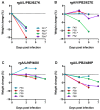Insights into the Acquisition of Virulence of Avian Influenza Viruses during a Single Passage in Ferrets
- PMID: 31590265
- PMCID: PMC6832663
- DOI: 10.3390/v11100915
Insights into the Acquisition of Virulence of Avian Influenza Viruses during a Single Passage in Ferrets
Abstract
Circulating avian influenza viruses pose a significant threat, with human infections occurring infrequently but with potentially severe consequences. To examine the dynamics and locale of the adaptation process of avian influenza viruses when introduced to a mammalian host, we infected ferrets with H5N1 viruses. As expected, all ferrets infected with the human H5N1 isolate A/Vietnam/1203/2004 showed severe disease and virus replication outside the respiratory tract in multiple organs including the brain. In contrast infection of ferrets with the avian H5N1 virus A/Chicken/Laos/Xaythiani26/2006 showed a different collective pattern of infection; many ferrets developed and cleared a mild respiratory infection but a subset (25-50%), showed extended replication in the upper respiratory tract and developed infection in distal sites. Virus from these severely infected ferrets was commonly found in tissues that included liver and small intestine. In most instances the virus had acquired the common virulence substitution PB2 E627K but, in one case, a previously unidentified combination of two amino acid substitutions at PB2 S489P and NP V408I, which enhanced polymerase activity, was found. We noted that virus with high pathogenicity adaptations could be dominant in an extra-respiratory site without being equally represented in the nasal wash. Further ferret passage of these mutated viruses resulted in high pathogenicity in all ferrets. These findings illustrate the remarkable ability of avian influenza viruses that avoid clearance in the respiratory tract, to mutate towards a high pathogenicity phenotype during just a single passage in ferrets and also indicate a window of less than 5 days in which treatment may curtail systemic infection.
Keywords: H5N1 influenza virus; avian influenza; ferret; mammalian adaptation; systemic infection.
Conflict of interest statement
The authors declare no conflict of interest. The funders had no role in the design of the study, in the collection, analyses, or interpretation of data, in the writing of the manuscript, or in the decision to publish the results.
Figures





Similar articles
-
Airborne transmission of influenza A/H5N1 virus between ferrets.Science. 2012 Jun 22;336(6088):1534-41. doi: 10.1126/science.1213362. Science. 2012. PMID: 22723413 Free PMC article.
-
Enhanced virulence of clade 2.3.2.1 highly pathogenic avian influenza A H5N1 viruses in ferrets.Virology. 2017 Feb;502:114-122. doi: 10.1016/j.virol.2016.12.024. Epub 2016 Dec 27. Virology. 2017. PMID: 28038412 Free PMC article.
-
Highly pathogenic avian influenza A(H5N1) virus of clade 2.3.4.4b isolated from a human case in Chile causes fatal disease and transmits between co-housed ferrets.Emerg Microbes Infect. 2024 Dec;13(1):2332667. doi: 10.1080/22221751.2024.2332667. Epub 2024 Jun 13. Emerg Microbes Infect. 2024. PMID: 38494746 Free PMC article.
-
Use of animal models to understand the pandemic potential of highly pathogenic avian influenza viruses.Adv Virus Res. 2009;73:55-97. doi: 10.1016/S0065-3527(09)73002-7. Adv Virus Res. 2009. PMID: 19695381 Review.
-
[Pathogenicity and transmissibility of cow-derived H5N1 highly pathogenic avian influenza viruses].Uirusu. 2024;74(2):117-130. doi: 10.2222/jsv.74.117. Uirusu. 2024. PMID: 40024794 Review. Japanese.
Cited by
-
An Outbreak of Highly Pathogenic Avian Influenza (H7N7) in Australia and the Potential for Novel Influenza A Viruses to Emerge.Microorganisms. 2021 Jul 31;9(8):1639. doi: 10.3390/microorganisms9081639. Microorganisms. 2021. PMID: 34442718 Free PMC article. Review.
-
Cross-species infection potential of avian influenza H13 viruses isolated from wild aquatic birds to poultry and mammals.Emerg Microbes Infect. 2023 Dec;12(1):e2184177. doi: 10.1080/22221751.2023.2184177. Emerg Microbes Infect. 2023. PMID: 36877121 Free PMC article.
References
-
- Jonges M., Meijer A., Fouchier R.A., Koch G., Li J., Pan J.C., Chen H., Shu Y.L., Koopmans M.P. Guiding outbreak management by the use of influenza A(H7Nx) virus sequence analysis. Eurosurveillance. 2013;18:20460. - PubMed
Publication types
MeSH terms
LinkOut - more resources
Full Text Sources
Medical
Research Materials
Miscellaneous

